Japandi Style

Japanese Zen really focuses on a few things. First of all, there are a lot of simple and clean furniture pieces kept quite low to the ground. Colours as well are generally simple. Colour palette tend to be little bit darker. It tends to embrace a lot of earthy tones such as rust, browns, beiges and greens etc. This use of dark colours and earth tones are meant to evoke sort of a feeling simplicity and tranquil space which is looking beautiful and comfortable. You can see a sample image for the reference which is ideally showing how Japandi style should look.

Scandinavian Style, on the other hand, is similar to Japanese Zen in terms of the simplicity. However, Scandinavian tends to use a much lighter colour palette for flooring and furniture though. Probably, that’s the biggest difference between these two styles. In Scandinavian style, what we are trying to do here is to create a space light and open.
What are the benefits of Japandi?
Benefits of this, as we can tell, is that you’re creating a beautiful, calming and serene place but at the same time it’s usually quite light and airy. Bad news is if you are someone who likes big pops of colours, *bright bright* blues, yellows and reds etc, this Japandi trend may not be a good fit for you as it tends to have much more muted colours and shades.
Also, if you are a fan of traditional ornamentations, you and Japandi may not be a good match.

How to design your in Japandi Style
Keep it simple
It means using simple furniture, rugs, curtains or anything with basic shapes since these two Japanese Zen and Scandi are more minimalist styles. We should not do anything super traditional.
Use Lots of Earthy and Neutral Colours
Wood tones are probably one of the biggest differences Japanese Zen and Scandi. Here, we can play with contrast which is quite cool about Japandi. Neutral tones will create space that’s calming and relaxing. Sometimes, what we might notice when we are dealing with big patterns or colours, it can be draining. Japandi does really well and it just makes a space that evokes that feeling of calm and comfortable. In a nutshell, at the end of the day, we are looking for muted colour choices and things that are toned down.
Japandi style rugs: A perfect addition to your space
One of the most captivating elements that can elevate the Japandi style in your home is the incorporation of Japandi style rugs. These exquisite floor coverings serve as a canvas upon which the principles of Japanese Zen and Scandinavian minimalism are woven together, creating a harmonious and visually striking focal point.
Characteristics of Japandi style rugs
Japandi style rugs are distinguished by their understated elegance and attention to detail. They often feature natural fibers such as wool, jute, or sisal, celebrating the beauty of organic materials and their inherent textures.
The color palette of Japandi style rugs is typically muted and earthy, with shades of beige, gray, and warm neutrals that create a serene and calming atmosphere. These rugs may also incorporate subtle patterns or geometric designs that pay homage to traditional Japanese and Scandinavian motifs.
In addition to their visual appeal, Japandi style rugs are prized for their durability and practicality. Many are handcrafted using time-honored techniques, ensuring their longevity and ability to withstand the demands of daily life.

How to incorporate Japandi style rugs in different rooms
Japandi style rugs can seamlessly complement a variety of interior spaces, adding warmth, texture, and a sense of grounding to any room.
-
Living Room: In the living room, a Japandi style rug can serve as the centerpiece, anchoring the furniture arrangement and creating a cozy and inviting atmosphere. Choose a rug with a subtle pattern or a solid neutral hue to complement the minimalistic and natural elements in the space.
-
Bedroom: Introduce a sense of serenity and tranquility to your bedroom by incorporating a Japandi style rug. Opt for a plush, wool rug in a soothing shade to create a cozy and relaxing ambiance.
-
Dining Room: Japandi style rugs can add a touch of warmth and texture to your dining area. Consider a jute or sisal rug with a simple geometric pattern to complement the clean lines and natural materials of your dining set.
-
Entryway: Welcome guests with the understated elegance of a Japandi style rug in your entryway. A durable and low-pile rug in a neutral shade can create a lasting first impression and set the tone for the rest of your home.
Japandi style rug buying guide
When shopping for Japandi style rugs, consider the following factors to ensure you find the perfect piece for your space:
-
Material: Opt for natural fibers such as wool, jute, or sisal, which align with the principles of Japandi style and offer durability and warmth.
-
Color and Pattern: Stick to a muted color palette featuring earthy tones, neutrals, and subtle patterns or designs that complement the minimalistic aesthetic.
-
Size and Shape: Measure your space carefully and choose a rug size and shape that fits the dimensions of the room and furniture arrangement.
-
Pile Height: Consider the desired level of plushness and the intended use of the space. Low-pile rugs are ideal for high-traffic areas, while thicker, plush rugs create a cozy atmosphere in bedrooms or living rooms.
-
Quality and Craftsmanship: Invest in high-quality, handcrafted Japandi style rugs that are made to last and showcase the attention to detail and artistry of the makers.

Maintaining and cleaning Japandi style rugs
To ensure the longevity and beauty of your Japandi style rugs, proper maintenance and cleaning are essential. Here are some tips to keep your rugs looking their best:
-
Regular Vacuuming: Vacuum your rugs regularly to remove dirt, dust, and debris, which can accumulate over time and cause premature wear and tear.
-
Spot Cleaning: Address spills and stains promptly by blotting the area with a clean, absorbent cloth and using a mild, pH-neutral cleaner specifically designed for the rug's material.
-
Professional Cleaning: Consider having your Japandi style rugs professionally cleaned on a regular basis, typically every 12 to 18 months, to maintain their vibrant colors and remove deep-seated dirt and grime.
-
Rotating and Reversing: Rotate and reverse your rugs periodically to ensure even wear and prevent permanent indentations or discoloration from foot traffic or furniture placement.
-
Proper Storage: When not in use, store your Japandi style rugs in a cool, dry place, rolled or folded, and protected from direct sunlight and moisture to prevent fading and damage.
Modern Japandi Rug Ideas: Fusion of Scandinavian and Japanese Aesthetics
Modern Japandi rug ideas seamlessly blend the minimalist principles of Scandinavian and Japanese design. These rugs often feature clean lines and neutral colour palettes, with occasional hints of muted, earthy tones. Look for rugs made from natural fibres such as wool, jute, or bamboo silk to embrace the Japandi ethos of connecting with nature. Subtle textures and geometric patterns are common elements that add interest without overwhelming the space. Consider rugs with asymmetrical designs or hand-woven details to bring a touch of wabi-sabi to your modern Japandi interior.
Japandi Rug Ideas Pinterest: Curated Inspiration for Harmonious Spaces
Pinterest serves as a rich source of Japandi rug ideas, showcasing how these floor coverings can transform a space. Popular pins often feature large, minimalist rugs that anchor a room with their subtle presence. Look for boards highlighting textured neutrals, such as cream, beige, and soft grey rugs that complement both light and dark furniture. Natural fibre rugs with simple patterns are frequently pinned, reflecting the Japandi preference for organic materials. Pinterest also reveals clever ways to layer Japandi-style rugs, creating depth and interest while maintaining a serene atmosphere.
Japandi Rug Ideas for Living Room: Creating a Serene Focal Point
In the living room, Japandi rugs serve as a foundation for creating a calm, inviting space. Opt for large area rugs that define the seating area, preferably in muted tones like soft greys, warm beiges, or gentle blues. Consider rugs with subtle geometric patterns or textured weaves to add visual interest without overwhelming the space. Natural fibre rugs, such as wool or sisal, bring an organic touch that's essential to the Japandi aesthetic. For larger living rooms, experiment with layering a smaller, patterned rug over a larger, plain one to create depth and dimension.

Japandi Rugs: Essential Elements of Harmonious Design
Japandi rugs are key to achieving the perfect balance between Scandinavian functionality and Japanese minimalism. These rugs typically feature clean lines and simple designs, often in neutral colour palettes with occasional muted accent hues. Look for rugs made from natural materials like wool, cotton, or plant fibres, which align with the Japandi focus on sustainability and connection to nature. Textural elements are important, providing visual interest through subtle patterns or weave variations. Japandi rugs often incorporate asymmetrical designs or imperfect elements, embracing the Japanese concept of wabi-sabi and adding character to the space.
Japandi Rug Bedroom: Crafting a Tranquil Sleep Sanctuary
In a Japandi-style bedroom, rugs play a crucial role in creating a peaceful atmosphere. Opt for soft, plush rugs that provide comfort underfoot and absorb sound. Neutral tones like cream, light grey, or pale taupe work well, promoting a sense of calm. Consider rugs with subtle textures or low-contrast patterns to add interest without disturbing the room's serenity. Natural fibre rugs, such as wool or bamboo silk, complement the Japandi aesthetic perfectly. For larger bedrooms, use a generously sized rug that extends beyond the bed, creating a cohesive and grounded look.
Japandi Rug Living Room: Balancing Form and Function
A Japandi rug in the living room serves as both a functional and aesthetic element. Choose large area rugs that define the seating area, creating a sense of cohesion. Opt for neutral colours with subtle variations to add depth without overwhelming the space. Textured rugs in natural materials like wool or jute bring warmth and interest while maintaining the Japandi principle of simplicity. Consider rugs with minimalist geometric patterns or abstract designs that echo the clean lines of Japandi furniture. For a truly harmonious look, select a rug that complements both the flooring and the furniture, creating a seamless blend of elements.
Japandi Style Living Room: Creating a Harmonious and Inviting Space
A Japandi style living room combines the warmth of Scandinavian hygge with the minimalism of Japanese design. Start with a neutral colour palette, incorporating shades of white, beige, and grey. Introduce natural materials like wood and stone through furniture and decor. Minimalist furniture with clean lines and functional design is key. Add textural elements through throws, cushions, and a carefully chosen rug. Incorporate plants to bring life and a connection to nature. Keep the space clutter-free, focusing on a few high-quality pieces that blend form and function. Lighting should be soft and warm, creating a cosy atmosphere that invites relaxation.
Japandi Style Kitchen: Blending Functionality with Aesthetic Simplicity
A Japandi style kitchen embraces minimalism without sacrificing warmth. Opt for sleek cabinetry in light wood tones or matte finishes. Open shelving displays carefully curated dishes and utensils, embodying the 'less is more' philosophy. Choose natural materials for countertops, such as wood or stone, to bring an organic feel. Incorporate minimalist lighting fixtures with clean lines. Use a neutral colour palette with occasional muted accent colours. Functional design is paramount, so ensure every element serves a purpose. Add warmth through textured fabrics like a natural fibre rug or linen tea towels. Keep surfaces clutter-free, storing appliances out of sight to maintain a serene atmosphere.
Japandi Style Bedroom: Crafting a Serene Sleep Sanctuary
Create a tranquil Japandi style bedroom by focusing on simplicity and natural elements. Choose a low-profile bed frame in light wood or a neutral upholstered design. Opt for high-quality, natural fibre bedding in muted tones like soft whites, greys, or earth tones. Incorporate minimalist bedside tables with clean lines and hidden storage. Use soft, warm lighting through table lamps or pendant lights with simple designs. Add a large area rug in natural fibres to define the space and add warmth underfoot. Keep decor minimal, focusing on a few carefully chosen pieces that bring calm and character to the room. Introduce plants to connect with nature and purify the air.
Japandi Style Bathroom: Zen-like Simplicity Meets Scandinavian Functionality
A Japandi style bathroom combines the serenity of Japanese aesthetics with the practicality of Scandinavian design. Opt for a neutral colour palette with whites, greys, and natural wood tones. Use large-format tiles or seamless surfaces to create a sense of space and simplicity. Incorporate natural materials like wood and stone in vanities, shelving, or bath mats. Choose minimalist fixtures with clean lines for taps, showerheads, and hardware. Add warmth through wooden elements like a bath tray or stool. Use plants to bring life and a spa-like feel to the space. Keep the bathroom clutter-free with hidden storage solutions, displaying only essential items in an organised manner.
Japandi Style Furniture: Blending Form and Function
Japandi style furniture embodies the perfect balance between aesthetics and practicality. Look for pieces with clean lines and minimalist designs that showcase the beauty of natural materials. Opt for light wood tones or matte black finishes to create contrast. Low-profile furniture is common, creating a sense of space and tranquility. Choose pieces with dual functionality, such as storage ottomans or extendable tables. Upholstered items should feature natural fabrics in neutral tones. Incorporate handcrafted elements to add character and embrace the wabi-sabi aesthetic. Remember, each piece should serve a purpose and contribute to the overall harmony of the space.
Japandi Style Clothes: Minimalist Wardrobe Essentials
While Japandi is primarily an interior design style, its principles can extend to fashion. Japandi style clothes focus on minimalist designs and high-quality, natural fabrics. Opt for a neutral colour palette with shades of white, beige, grey, and black, occasionally incorporating muted earth tones. Choose loose-fitting silhouettes that prioritise comfort and functionality. Layer pieces for depth and interest while maintaining a clean overall look. Invest in timeless, versatile items that can be mixed and matched easily. Accessories should be minimal and purposeful, such as a simple watch or handcrafted jewellery. Embrace the concept of a capsule wardrobe, keeping only essential pieces that truly bring joy and serve a purpose.
Japandi Style House: Holistic Approach to Harmonious Living
A Japandi style house embraces a holistic approach to design, creating a harmonious living environment throughout. Start with a neutral colour palette as the foundation, incorporating natural materials like wood, stone, and bamboo. Minimalist architecture with clean lines and open spaces sets the tone. Large windows invite natural light and connect the interior with the outdoors. Furniture should be functional and aesthetically pleasing, with a mix of Scandinavian and Japanese influences. Incorporate natural textures through rugs, throws, and cushions. Declutter regularly to maintain a sense of space and serenity. Add carefully chosen decor items that bring joy and reflect personal style. Remember, a Japandi style house is not just about looks; it's about creating a calm, balanced environment that promotes wellbeing and mindful living.
People Also Asked
What is Japandi design style?
Japandi is a hybrid interior design style that blends Japanese minimalism with Scandinavian functionality. It emphasizes clean lines, natural materials, and a muted color palette to create serene, uncluttered spaces.
Why is Japandi so popular?
Japandi's popularity stems from its harmonious blend of two beloved design aesthetics. It offers a perfect balance between comfort and minimalism, appealing to those seeking calm, functional spaces in an increasingly chaotic world.
Is Japandi style expensive?
While Japandi can incorporate high-quality, artisanal pieces, it's not inherently expensive. The style's focus on minimalism and functionality allows for a range of budget options without compromising on aesthetic appeal.
What is the difference between Scandi and Japandi?
Scandi design tends to be lighter and brighter, while Japandi incorporates darker tones and more natural textures. Japandi also places a stronger emphasis on craftsmanship and the Japanese concept of wabi-sabi.
Does Japandi use leather?
Japandi can incorporate leather, particularly in natural, earthy tones. However, it's used sparingly and often in high-quality, minimalist pieces that align with the style's focus on natural materials and craftsmanship.
What style is similar to Japandi?
Styles similar to Japandi include Minimalism, Modern Zen, and Scandinavian. These styles share Japandi's emphasis on simplicity, functionality, and a connection to nature.
What colors are used in Japandi style?
Japandi typically uses a muted, natural color palette. This includes warm neutrals, soft whites, charcoal grays, and pale pastels, often accented with black for contrast.
Is Japandi timeless?
Japandi's focus on simplicity, functionality, and natural elements gives it a timeless quality. While trends may influence some aspects, its core principles are likely to remain relevant and appealing for years to come.
Who invented the Japandi style?
Japandi wasn't invented by a single person but evolved naturally from the cultural exchange between Japan and Scandinavian countries. It gained recognition as a distinct style in the mid-2010s.
What is the difference between Japandi and boho?
Japandi emphasizes minimalism and muted colors, while Boho embraces maximalism and vibrant hues. Japandi focuses on clean lines and uncluttered spaces, whereas Boho celebrates eclectic, layered designs.
How old is Japandi style?
While the cultural exchange influencing Japandi dates back centuries, the term and recognized style emerged in the mid-2010s. It has gained significant popularity in interior design circles over the past 5-7 years.
What are the rules of Japandi style?
Key rules of Japandi style include:
- Embrace minimalism
- Use a muted color palette
- Incorporate natural materials
- Focus on functionality
- Celebrate craftsmanship
- Create uncluttered spaces
- Balance comfort with aesthetics
What is modern Japandi style?
Modern Japandi builds on traditional Japandi principles while incorporating contemporary elements. It might include more tech-integrated furniture, sustainable materials, or bold accent pieces while maintaining the core aesthetic of simplicity and nature-inspired design.
What is the difference between minimalism and Japandi?
While both emphasize simplicity, Japandi is less austere than pure minimalism. Japandi incorporates more textures, natural elements, and a warmer color palette. It also places greater emphasis on comfort and the aesthetic quality of each item, not just its function.
What is the Japandi style?
Japandi style is a fusion of Japanese minimalism and Scandinavian functionality. It emphasizes clean lines, natural materials, and a neutral color palette to create serene, harmonious living spaces.
Is Japandi still trendy?
Yes, Japandi remains trendy in 2025. It's evolving to include warmer tones, richer textures, and a deeper connection to nature, while maintaining its core principles of simplicity and functionality.
Why is Japandi so expensive?
Japandi can be expensive due to its focus on high-quality, natural materials and handcrafted elements. The style prioritizes timeless, durable pieces over trendy, disposable decor, which often comes at a higher initial cost.
What are the rules for Japandi design?
Key rules for Japandi design include:
- Use a neutral color palette with occasional muted accents
- Incorporate natural materials like wood and stone
- Embrace minimalism and decluttered spaces
- Focus on functionality and multi-purpose furniture
- Integrate biophilic elements to connect with nature
How do I get the Japandi look?
To achieve the Japandi look:
- Choose furniture with clean lines and natural finishes
- Opt for a muted color scheme with earthy tones
- Incorporate plants and natural light
- Use textured fabrics like linen and wool
- Add handcrafted accessories for warmth and character
Can you mix Japandi and Mid-Century?
Yes, Japandi and Mid-Century styles can be mixed. Both share an appreciation for clean lines and functional design. Combine Mid-Century statement pieces with Japandi's neutral palette and natural materials for a harmonious blend.
What is the most popular style in Japan?
While Japandi is popular globally, traditional Japanese interior styles like Wabi-Sabi and Zen remain influential in Japan. These styles emphasize simplicity, natural imperfections, and a connection to nature.
How do you pronounce Japandi?
Japandi is pronounced as "juh-PAN-dee", combining the first syllable of "Japan" with the ending of "Scandi" (short for Scandinavian).
Related Posts
Related Rug Collections




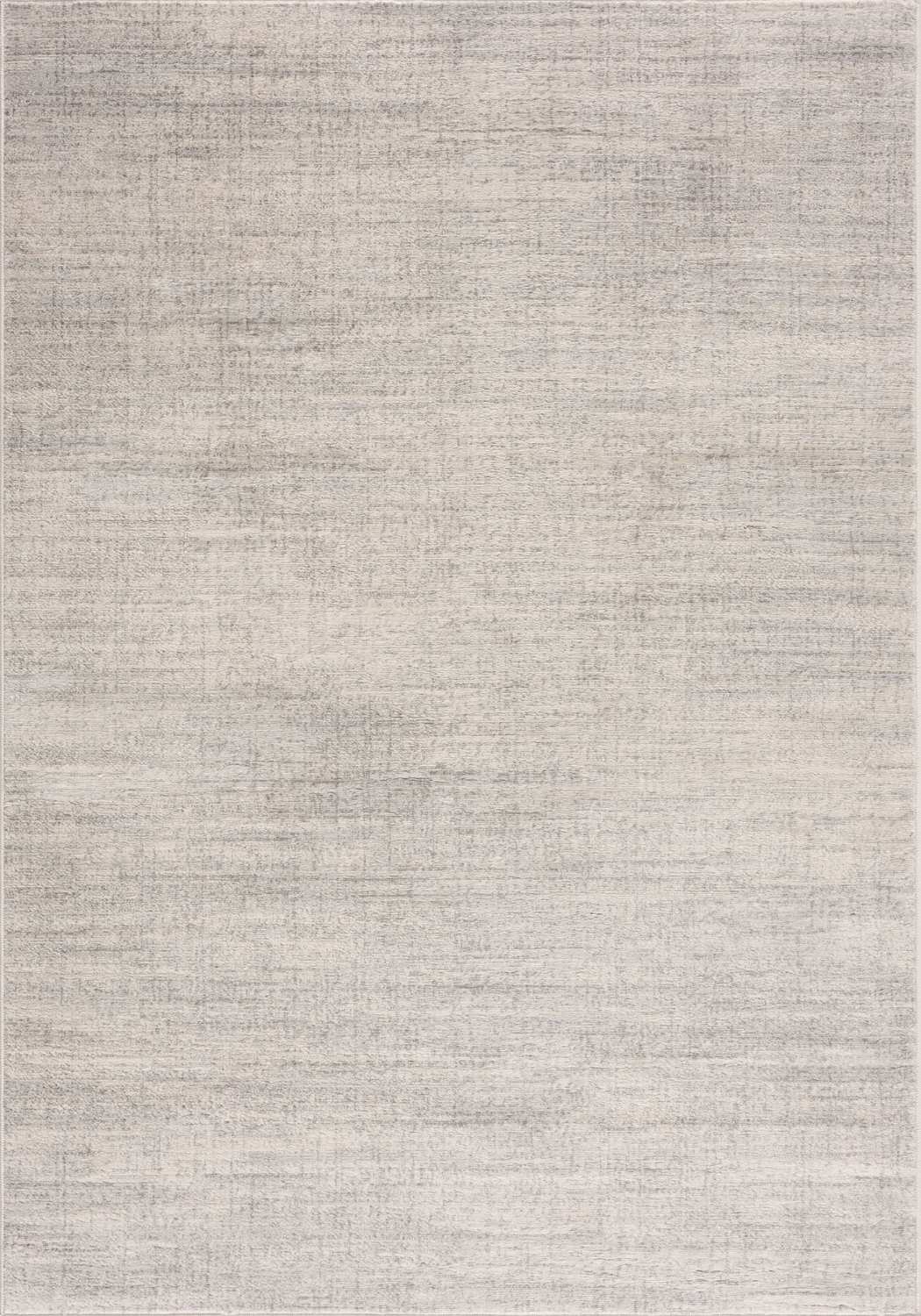
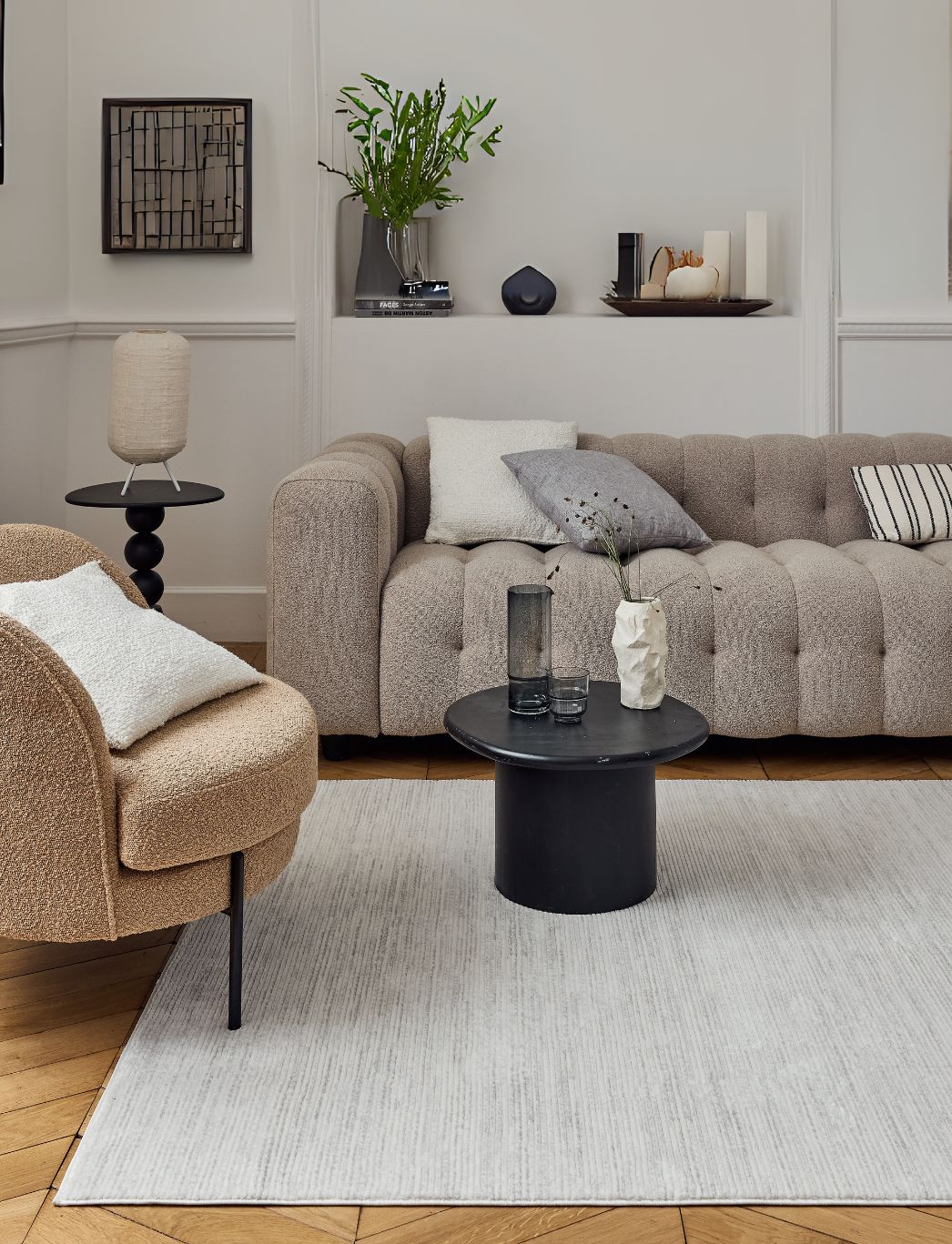
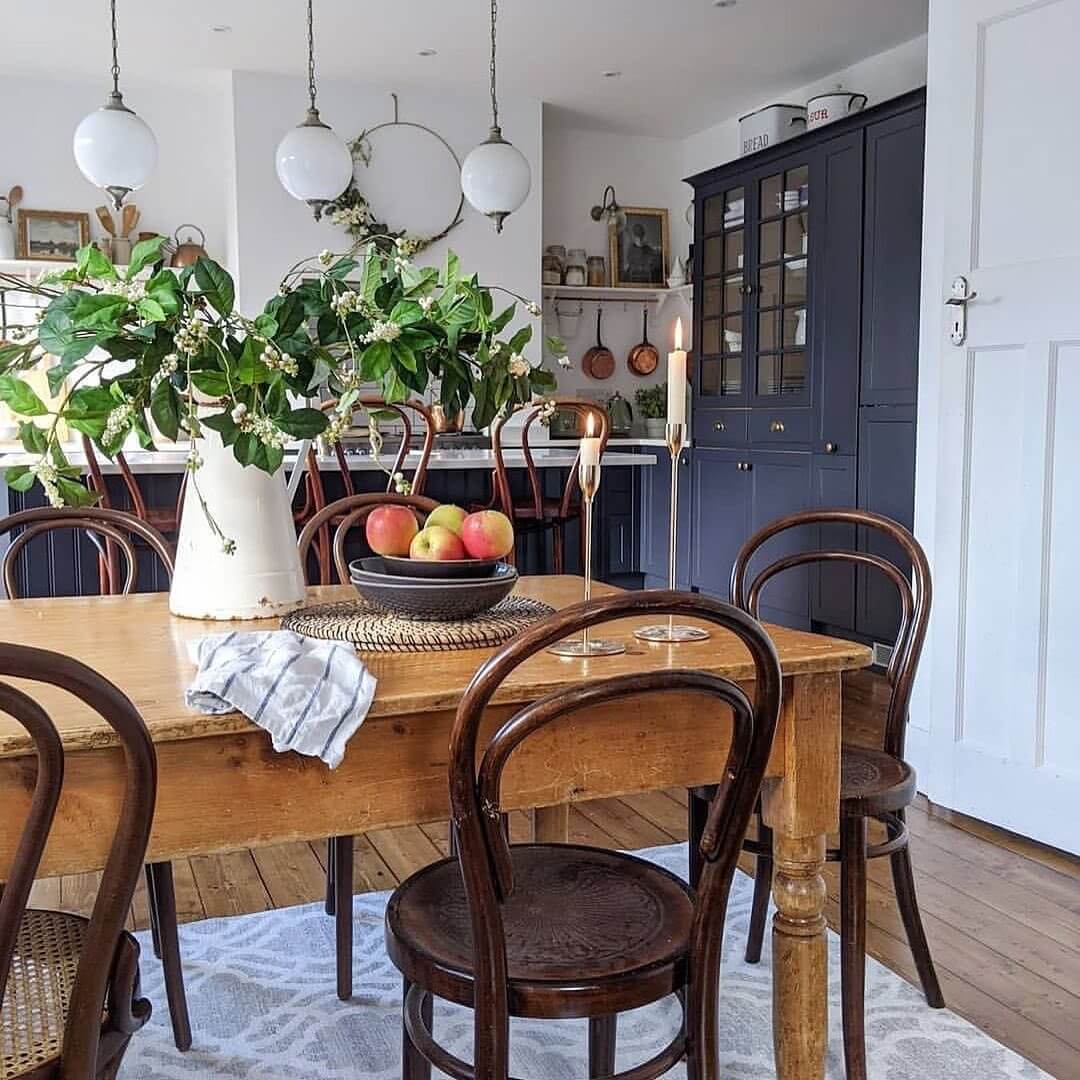
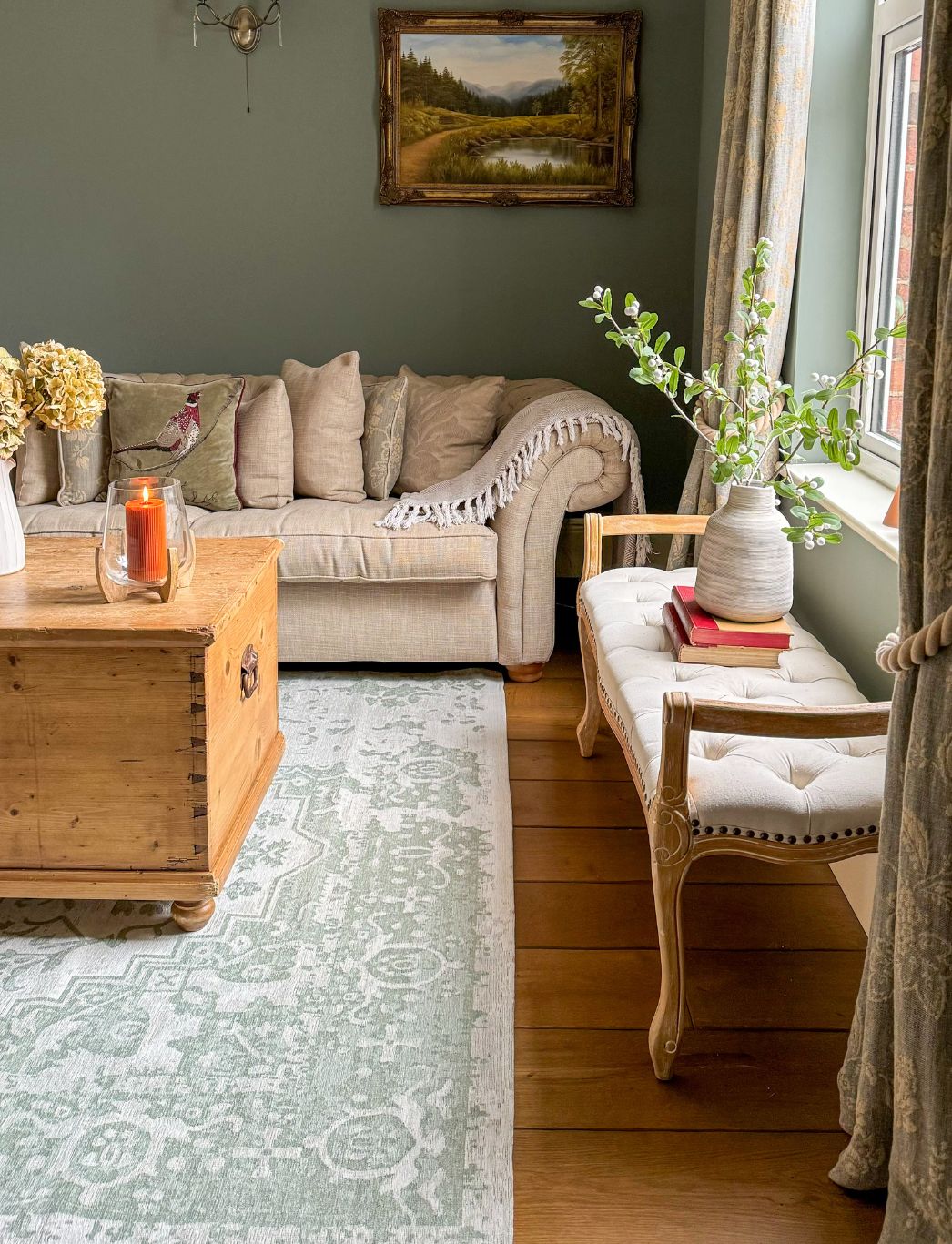
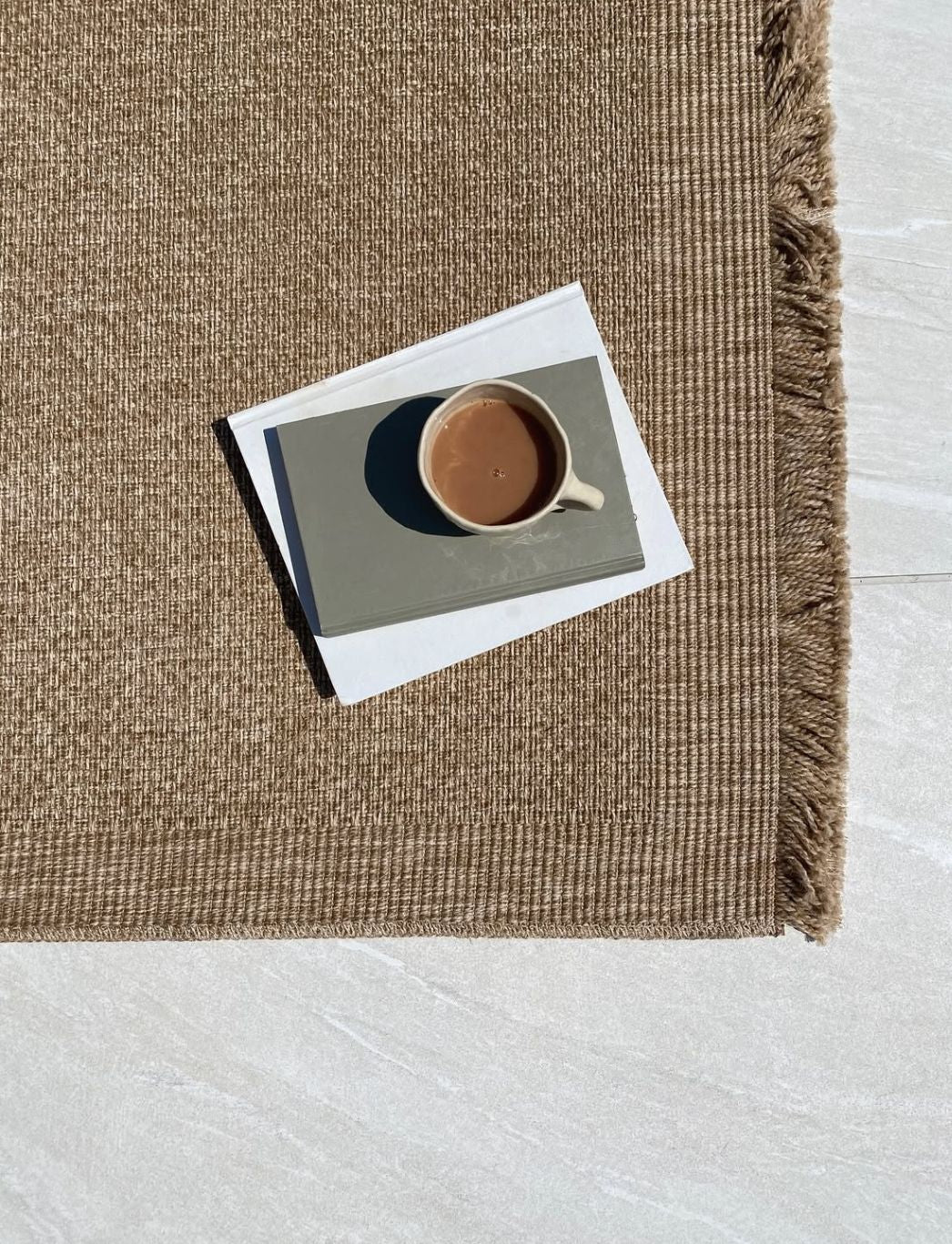
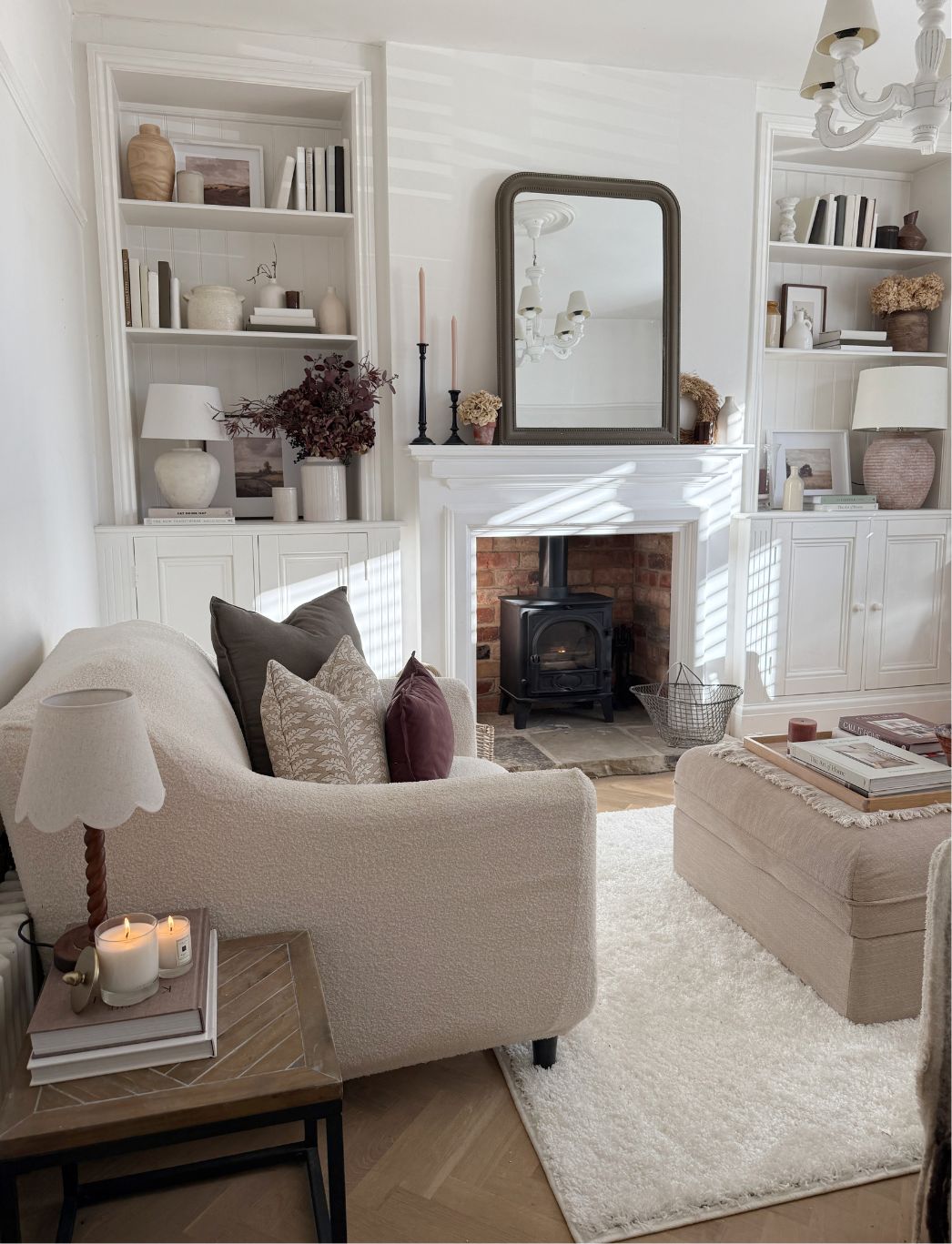
Leave a comment